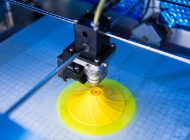 Both injection moulding and 3D printing are popular in the world of product development and manufacturing nowadays. Each of this method is versatile and well-suited to certain conditions.
Both injection moulding and 3D printing are popular in the world of product development and manufacturing nowadays. Each of this method is versatile and well-suited to certain conditions.
These 2 methods are also different in many aspects. For product developers and engineers, it may be challenging to choose especially when you do not have enough knowledge with these manufacturing processes. Hence, it is vital to know some of their key differences.
As a guide, here is a blog post about which is the best production method for your project – 3D printing vs Injection moulding. Read on more below.
Details about each method
Injection moulding is a manufacturing process of injecting molten material into a mould. Material granules are fed through a hopper into a heated barrel. It is then melted using heater bands. Then the plastic is injected through a nozzle into a mould cavity where it cools and hardens. When the part already solidifies, a platen will open and the part is ejected out using ejector pins.
3D printing works by extruding molten plastic through a nozzle that moves precisely under computer control. This is done successively, layer by layer until an object is formed.
Which is suitable for items with complex designs
In injection moulding, there are some shapes and designs that are extremely costly to create. Some are even impossible to create using injection moulding. The complexity of the product can also affect the initial mould price and overall production cost.
On the contrary, 3D printing is capable of producing creative parts. Even items with impossible designs and intricate details, lattice structures, parts within parts are possible to be produced with 3D printing.
Which one is ideal for project that requires high-volume production
Injection moulding is ideal for situations when high-volume production is required. Once a mould is created, the molten plastic is injected over and over again to produce the same exact result. Nevertheless, when attempting to produce low volume of parts, costs can go up and the overall practicality of using injection moulding is reduced.
Conversely, 3D printing is a good choice for low-volume projects such as on-demand businesses. Moreover, some businessmen choose 3D printing to keep overhead cost down and to only create 3D parts as they are ordered or requested.
Which is more cost-effective
Most injection moulding machines are usually found in dedicated shops that specialize in this production method. This is because injection moulding has large upfront cost. As a capital investment, a good injection moulding machine can cost several thousand dollars. Thus, the injection moulding machine is not something that businessmen and product creators would simply purchase. The cost will also vary depending on how many units are required to be produced.
Fortunately, there is no upfront cost for 3D printers unlike injection moulding. If you are working with a 3d printing service provider, your financial responsibility is only the service cost which including the cost of the raw material used in the process. If you DIY, purchasing your own 3D printer can only cost you a few thousand dollars and maybe a lot more depending on the quality and accuracy you would like to have for your 3d parts.
Which is more advantageous when it comes to speed/production time
For injection moulding, speed and time of production can vary. Pre-production processes such as producing a prototype, developing a mould, etc. can take a lot of time. Whereas, the actual injection moulding process may only take a few seconds or minutes.
3D printing may usually take a few hours to make the actual part depending on the size and design. Nevertheless, you can immediately start prototyping as soon as the design is ready compared to injection moulding in which case you will have to wait for weeks or months to create a custom mould.
Which method should you choose if you want to make iterations or changes easily on the product’s design
When creating items with injection moulding, you only have a dedicated moulding for a specific project. Injection moulding does not have the capability for iteration and changes after a mould is made. All iterations should be made during the pre-production process.
Being able to iterate and change design is one of the strengths of 3D printing. Even after an item is printed, changes on the design can be easily made by updating the CAD file and printing the entire part again. Moreover, you can create many iterations of a design within a short time frame.
Conclusion
Injection moulding and 3D printing are two of the widely known product development process today. Injection moulding is preferred for projects with simple geometries and extremely high production runs. While 3D printing is mostly used for lower-quantity applications with highly complex parts.
Both have their own strengths and can be used according to your preferences and needs. If you think that 3D printing is ideal for your project, then you can go to a reputable 3D printing service company and ask for professional help.








